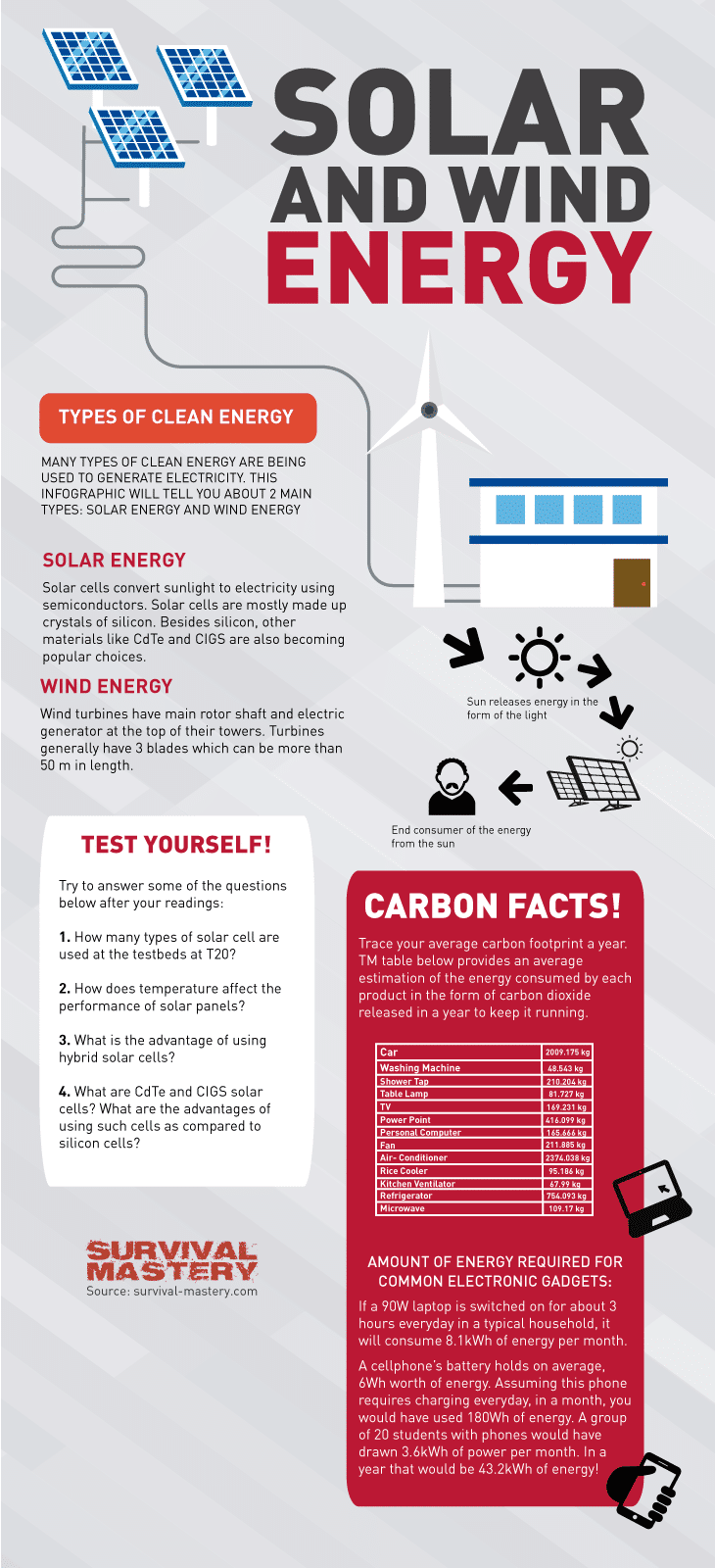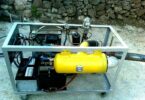As electricity use increases exponentially day-by-day, man needs to method out better ways of harnessing electricity at individual level. This sole solution is the use of solar energy, which can create a sustainable form of energy that does not deplete owing to all blindfolded use of energy by humanity.
[the_ad_placement id=”in-text-1-type-r”]With choosing to harness energy from sunlight, you not only imprint the practice of your knowledge and its power, but also you make the environment healthier, safer and non-polluted in the longer run. Read ahead, to know how solar energy works and how to make it work on your own!
What is Solar energy?
Solar energy is harnessed from solar power which is energy or fuel made from sunlight. This is usually done with the help of advanced mechanical equipments that make electricity directly from sunlight with the help of photovoltaic (PV) energy or concentrated solar power (CSP). These equipments use things like Solar panels, Utility Grids, Utility Meters, Electrical Panels, Inverters and PowerGuide monitoring systems. PV processes sunlight using the photovoltaic effect.

Historically, the first PV cell was made in the late 1800s by Charles Fritts and was commercially produced five decades later. Since the 80s there has been a booming increase in the commercial level of solar power. The duration of a presently available photovoltaic cell is 25 to 40 years of functioning with little or no maintenance.
How does Solar energy work
Making solar power on your own is truly a good saving plan on your electricity. Moreover, making your own solar power also gets you the bonus benefits of living off the grid, in the best terms. When you are no longer part of the national electricity grid, the sense of independence also adds to the realization of using electricity properly.
Solar power cells use the speed energy of the photons in sunlight to make an electric current with the help of a solar cell. Created in the core of the sun, it takes roughly about a million years for a photon to reach the surface of the Earth. Lighting our beautiful planet since years, this power is infinite, inexhaustible and the purest energy source.
The process of conversion of sunlight into electrical energy is how solar power is generated. Solar energy can be stored or used directly, according to the process of conversion or quality of the equipments used. Starting with the beginning, you should know that there are three types of cells used for this: single-crystal, polycrystalline amorphous and silicon.
The most popular cells are those made of silicon and these are going to be considered in our article. Sunlight is constituted by miniscule photons that radiates off the sun. As the silicon in the solar cell is hit by photons, it transfers its energy onto the electrons around resulting in separating them from the atoms.
Solar cell frees up the electrons and then ushers them into an electric current. This, in turn, creates instability in the cell, which structures it into a slopping or descending direction making the electrons flow in the right direction. The internal organization of silicon is structurally tight here.
Given the fact that the silicon is a semi-conductor, two different substances are usually embedded onto this structure (phosphorus and boron) to create two types of charges. This helps with the movement of the electrons, who leave holes in their initial slot. The result is the creation of two types of electrons called p-type (positive) and n-type (negative).
When the two types are kept side by side, the electrons in the new structure jump into the other structure’s empty slot. This result in both structures getting charged positively and respectively negatively.
Simply put, the cells convert sunlight into direct current during the day, the inverter converts DC into AC, and an electrical panel supplies electricity necessary for an entire house.

There are many incredible ways to harness clean and renewable energy and using solar power is easy and convenient even for amateurs. First, choose your location, equipment, budget and process. Some of these methods are listed in the following ideas.
Make a solar panel and learn how solar energy works
Making a solar panel is the best way to understand how the solar energy is transferred from the sun into your home and powering your appliances. Anything from purchasing the cells and up to actually mounting the panel on your roof (or in another place oriented towards South) will teach you a little bit more about solar power. See our article on DIY solar panels for more information that can help you.
Put the cells together in a panel (steps to follow)
Buy the cells: best cost efficient cells to buy are polycrystalline cells. Firstly, be cautioned with handling these cells, as they are extremely fragile. Buy cells equivalent to the watt/ energy you need. Buy extra cells to use in emergency.
Clean the cells: often, manufactures cover the cell in wax before shipping, for safety reasons. Before using the cell, keep it dipped in hot water that is strictly not boiling.
Make a board: this is used to attach the cells firmly. Measure the dimensions of your cells and cut a board with extra inches off its edges, to connect the wire, in the future.
Wiring: Cut the required measurements of wire you need for the cells. Two lines are directed in two directions of short and respectively long measurements. The tabbing wire in this process ought to follow the long two lines to connect to the next cell, on its back. Measure length of this large line, double its length, and then cut off two pieces of wire for each of your cell.
Soldering: If you do not have pre-soldered tabbing, create a slim coating of solder on the squares on the back of you cells. Heat the top half of the tabbing wire on top of the soldering to attach it to the cell. Repeat the same with all the strips.

Image credit: instructables.com
Connect cells: Glue the cells onto the board with keeping the wires open, free and loose.
Fix cells on the board: Keep the cells in horizontal direction, in few numbers. When placing the cells, leave an inch extra on either side.
Solder the cells: Solder the cells together using the tabbed wire to connect it from the back of a cell to the front another cell.
Connect the first row: The extended tabbing wire from the soldering in the step prior should be, soldered with bus wire to fill in between the thick lines of cells.
Connect the second row: Connect the tabbed wire from the end of first row to the front of the second row with long bus wire. Connect the four wires onto the bus wire.
Connect all the rows: Connect rows using long bus wires, except at the end for which, and use the shot bus wires.
Make the panel box
Measure the dimensions of you cell panel (the one you made earlier), leaving an inch at all edges to include perfect fit of the cells alongside loose or extra wirings. Next cut some plywood to make a flat back for your panel box; this should cover the cells. Screw and bolt the sides using properly measured wood panels
Paint: If you are hoping to keep the solar panel in open air, painting is necessary for the box, to secure itself from the wear and tear of time.
Attach the solar panel: Glue the panel into the box with the cells. Make sure you keep the cells facing towards sun, so that you can get enough sunlight for your use.
Wire the panel using batteries
Connect the final bus wire with a diode using silicone. Next connect the light-shaded end to the negative marker of the battery and the opposite end to the positive end of the panel. These connections prevent flow of charge backwards when the equipment is not in use. Continuing, connect the black shaded wire on the diode and run this on a terminal block.
Connect the white wire from the short bus wire opposite to the terminal block. Now, connect the panel to a charge controller, connect the charge controller to the batteries and run the battery!
Seal the box
Buy the necessary amount of Plexiglas required for you panel/ box and screw it onto the panel, firm and tight. Make block stops and attach it to secure you glass on the box. Use a sealant of silicone to seal the edges of your panel box and make sure the box is watertight
Mount the panel
There are various ways of mounting a panel, such as
- on a cart to keep changing the direction, following the Sun;
- on the rooftop by keeping the angle consistent perpetually with the sun;
- on a Satellite Stand, which can be changed with respect to the sun’s beam
As you can see, making a solar panel is not such a big deal; you just need the right tools and the solar cells.

Of course that you can buy them from reliable producers but they will be more expensive and you won’t have as much fun as when you’re learning by doing. Here’s an informative piece that you can use on how to install solar panels – it’s a must-read!
Solar power generators
Continuing the lesson, let’s discuss about one of the best and efficient ways of making your own energy: the solar power generators. These have a fantastic commercial success but making one is not such a hassle.

Simply follow the steps described bellow and you should have your own solar generator in no time.
[the_ad_placement id=”in-text-2-type-r”]Things you’ll need:
- Solar Panel,
- Inverter,
- Wire connectors,
- Wires,
- Charge controller,
- Inverter and Battery.
Start by connecting the battery and inverter with the wires by connecting negative-to-negative and positive to positive. Connect the battery to the charge controller and now connect this concoction to the solar panel. Follow connecting negative poles of the wires first and leave your setup with the solar panel facing sunlight.

When charged at above 50% connect your house to the inverter and test it up. This can power up a standard light bulb of 60W for about 7 hours, 16 W for 25 hours, a TV for about 3 hours, an X box One for 3.5 hours, a laptop for 5.5 hours and a DVD player for oddly 12 hours.
As you can see with a reliable plan and proper knowledge, it’s easy to set up your solar power at home for less than $300 which is extraordinarily less than what producers charge for their systems. Here is our shopping list:
- Battery 12 V – One rated gel/ acid/ lead: at an RV or Greenbatteries Store
- Battery Box: $10
- 12 V DC Meter: $25
- DC Input: $10- triple inlet model
- Inverter: $50- 115 V 140 W
Do the connections and wiring as necessary (as described on the first step) and in 5-8 hours of charging, your home solar power will be ready for 5 hours of steady use at 115 V AC. Still, you have to remember that this is a homemade system and its reliability only depends on your skills. All the information presented here are purely theoretical and their purpose is to teach you about how solar energy works.
Solar energy pros and cons
Solar energy seems like all pros at first sight, but is it really? Let’s see which are the advantages and disadvantages of solar energy systems.
Advantages of using solar energy
Power saving: In the grave age of energy scarcity, it is necessary for everyone to start making his or her own energy. Power saving feature of solar energy is the best enticing feature of the same.
Money saving: With saving power on exorbitant electricity bills, you save a lot of money. No longer are you bound to pay your bills in the middle a random busy day!
No wastage of electricity: Saving money on electricity might not seem fascinating, but when those bills stop coming you will understand the personal growth you have, owing to making your own energy.
Unlimited/ Limited energy: The best aspect of making your own energy is that it is unlimited. Solar power is truly infinite, regardless of all the dams drying up or not.
Renewable energy: Solar energy is one of the cleanest renewable energy. It is renewable as it is sustainable alongside the presence of sun and inexhaustible, owing to the longevity of the sun. In addition, it is a non-polluting energy source unlike burning dung gas or anything of the similar likes.
No air-pollution: As the process emits no greenhouse gases, our planet is double safe with more solar cells around the corner!
No noise pollution: Unlike the loud generators and loud lanes along the Electricity boards, solar power, produces no rant or rabble when functioning. This is surely a bonus to our world; every new gadget has a new key or tune on its own!
No carbon footprint: as there is no carbon, ejected or emitted during the energy transformation and processes, it leaves no carbon footprints.
Support the environment: live in peace and harmony with the nature, ahead!
Disadvantages of using solar energy
- Any Temporary/ Long-term malfunction can result in power-cut until fixed;
- Initial cost is heavy;
- Location of the solar panel is fixed and hence not adjustable to the sun – as the solar panel remains in one angle facing the sky, it receives very little sun and not the whole day’s sunlight;
- Fixed solar panels stop from receiving enough sunlight in varied seasons;
- Heavy maintenance costs: as the equipment itself costs a fortune, any malfunction will determine a hefty bill of professional maintenance;
- Inefficiency or absorption rate of 40% sunlight makes it a downside;
- This is not a completely reliable energy unless your cells are charged with sunlight without depletion. It is dependent on sunlight;
- Installation area is huge for bigger buildings;
- Cleaning is a hassle: if the solar panels are fixed on the rooftop, routine cleaning can be risky.
- As the panels are delicate due care should be taken when handling them at all times, making it vulnerable even-more!
Tips to harness solar energy
Some advice from the Pros to keep off the danger, damage and wastage while making your own solar power are, listed below!
- Increase efficiency of you solar panel by keeping it clean periodically
- Always have knowledge of the electricity you are producing and depleting
- Conserve power and stop wasting energy unnecessarily
- Do energy consuming tasks during the day time
- Install controlled meters
- Eradicate all shade issues that is blocking sunlight from reaching your cells o panels
- Monitor the equipments periodically
- Keep yourself safe while handling tasks with electricity
- Handle the cells safely as they are fragile
- Use energy safely, smartly and efficiently!
In conclusion
Making your own energy gives you the independence to live truly off the grid and be aware about you energy uses.

It instills a sense of responsibility on energy wastage and newer ideas to conserve the same. Whatever your motive in making a solar power at home is, is not to be carried away or distracted by the internet jargon.
[the_ad_placement id=”in-text-3-type-r”]Talk to an expert if you are skeptical, but make sure you buy the best set and install it right away! In this age, making your own energy is indeed the smartest and the mandatory task everyone should be done with!
For the top solar panels in the market, see our article on how to choose the best ones today.
Good Luck to you!






Actually, a few of the disadvantages listed here are already obsolete. You can now build solar panels on your own which means you can maintain it on your own as well. This eliminates the heavy cost associated with solar panels. But of course, this only applies to DIY projects, although newer models are easier to clean and maintain. New solar cell developments has also allowed for more cheaper, yet stronger materials.
I’m not against solar energy, per se, I’m all for all renewable energy.
Realistically though, yes, the energy is there for the taking, but to convert solar energy to electricity costs a significant amounts of time, money and effort. You need to be invested in it body and soul.
It’ll take an extensive period of time until your investments start to pay off, especially if you rely on small solar energy devices in your day to day life.
However, when the circumstances change in the future, I hope it becomes cheaper and therefore more accessible.
I’ve read that researchers conduct experiments to use discarded batteries to fabricate perovskite-based solar cells. If this research will be proven even further, it will definitely benefit us, and the mother nature. However, I am just wondering, if every home has its own solar panel, can we use the excess power for industrial purposes?
So I understand thermal panels are relatively simply, but to install PV panels one has to know what he is doing.
I love the idea of solar panels, and I think the entire world should use more sources of renewable energy – wind turbines, and solar panels among others. However, the information on how to start building panels yourself is scarce. Would you recommend contacting a professional or attempting to buy and install the panels by myself?
We recommend that you buy and install panels by yourself, as long as you have enough info about solar energy and solar panels.